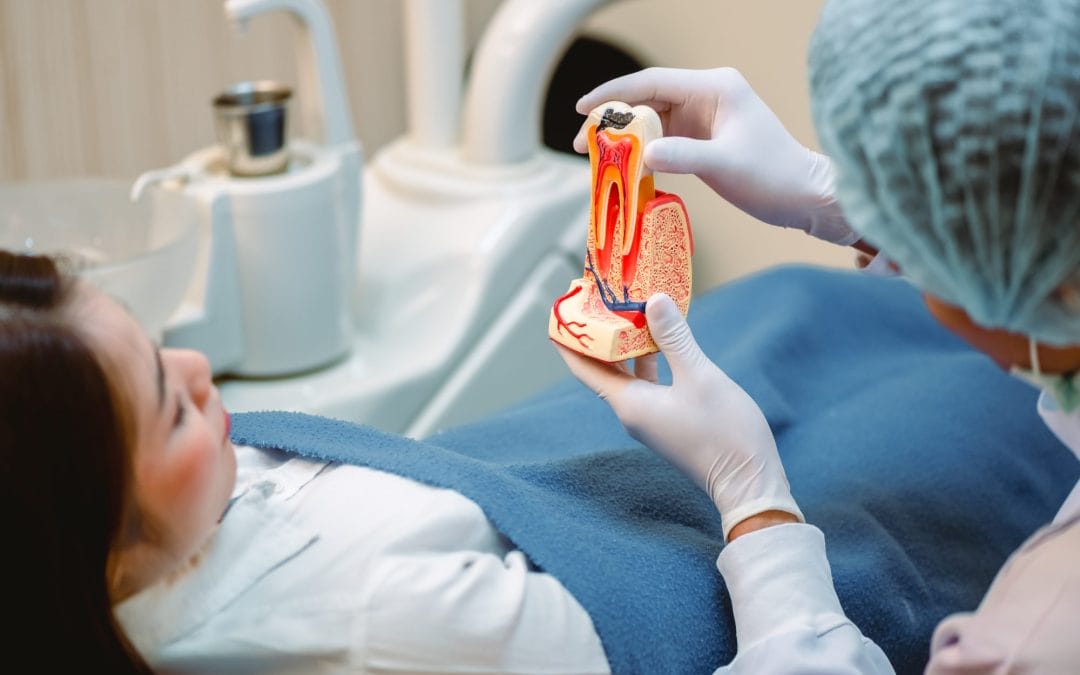If your dentist has recommended a root canal, you might be feeling a mix of emotions, anxiety, curiosity, or even confusion. Rest assured, you’re not alone. According to the American Association of Endodontists, root canals are one of the most common dental procedures performed today, and they’re designed to save your natural tooth while relieving pain and restoring your oral health.
At Dentistry of West Bend, we understand that the idea of a root canal can feel intimidating. That’s why we’re here to walk you through the process step by step, so you know exactly what to expect.
In this guide, we’ll explain what a root canal is, why it’s necessary, what happens during the procedure, and how to care for your tooth afterward. By the end, you’ll feel informed, reassured, and ready to take the next steps toward a healthy, pain-free smile.
What Is a Root Canal?
A root canal is a restorative dental procedure that treats an infected tooth or inflammation deep inside your tooth, down to the tip of the root. To understand how it works, it helps to know a little about the anatomy of your teeth.
Each tooth has a hard outer layer (enamel), a middle layer (dentin), and a soft inner core called the soft tissue pulp, located in the center of the tooth. The pulp contains nerves, blood vessels, and connective tissue that help your tooth grow during its early development. Once your tooth is fully formed, the pulp is no longer needed.
If the pulp becomes infected or inflamed, often due to a deep cavity, deep decay, a cracked tooth, or trauma, it can cause severe pain and lead to serious complications if left untreated. A root canal removes the damaged pulp from the root of the tooth, cleans and disinfects the inside of the tooth, and seals it to prevent further issues. This process allows you to keep your natural tooth rather than having it extracted.
Root canals are often misunderstood, but they play a critical role in preserving your oral health, according to Harvard Health Publishing. The best way to address the problem at its source is this procedure can prevent the need for more invasive treatments down the road.
Signs You May Need a Root Canal
How do you know if a root canal might be necessary?
Here are some common signs to watch for:
- Severe tooth pain when chewing or biting.
- Prolonged sensitivity to hot or cold, even after the source is removed, and a sensation of heat in your gums.
- Swollen or tender gums near the affected tooth.
- A pimple-like bump on the gums that doesn’t go away.
- Tooth discoloration, especially if the tooth appears darker than usual.
These symptoms don’t always mean you need a root canal, but they’re a good reason to schedule an appointment with your dentist. Early diagnosis and treatment can make all the difference in saving your tooth and preventing further complications.
It’s also worth noting that some people may not experience noticeable symptoms, especially in the early stages of pulp damage. Regular dental checkups are essential for catching potential issues before they become severe.
What Happens During a Root Canal Procedure?
Understanding what happens during a root canal can help ease any concerns you may have. The procedure typically involves the following steps:
1. Diagnosis and Preparation
Your general dentist will start by examining your tooth and taking X-rays to determine the extent of the damage. Once it’s confirmed that a root canal is needed, the area will be numbed with local anesthesia. This ensures you stay comfortable throughout the procedure.
If you’re feeling particularly anxious, your dentist may also offer sedation options to help you relax. At Dentistry of West Bend, we prioritize your comfort and will work with you to create a stress-free experience.
2. Accessing the Tooth
A small opening is made in the crown of your tooth to access the pulp chamber and root canals. This step is performed with precision to minimize the removal of healthy tooth structure.
3. Removing the Infected Pulp
Using specialized tools, your dentist will carefully remove the infected or damaged pulp from the tooth. This step eliminates the source of pain and infection.
4. Cleaning and Disinfecting
The empty canals are then cleaned and disinfected to remove any remaining bacteria or debris. This step is crucial for preventing reinfection and ensuring the long-term success of the treatment.
5. Filling the Canals
Once the canals are clean, they’re filled with a rubber-like material called gutta-percha. This material seals the canals to prevent reinfection.
6. Restoring the Tooth
Finally, the tooth is sealed with a temporary or permanent filling. In most cases, a crown will be placed during a follow-up visit to restore the tooth’s strength and function.
The entire process is usually completed in one or two appointments, depending on the complexity of your case. Your dentist will provide detailed instructions to ensure a smooth recovery and optimal results.
Does a Root Canal Hurt?
One of the most common misconceptions about root canals is that they’re painful. The truth is, modern root canal treatments are designed to relieve pain, not cause it. Thanks to advances in dental technology and local anesthetics, most patients find the procedure no more uncomfortable than getting a standard filling.
You may feel some mild soreness or sensitivity after the procedure, but this is temporary and can usually be managed with over-the-counter pain relievers. If you’re feeling anxious about the procedure, let your dentist know. At Dentistry of West Bend, we prioritize your comfort and can discuss options to help you feel at ease.
It’s important to remember that the pain you’re experiencing before the root canal is often far worse than any discomfort you might feel during or after the procedure. By addressing the issue promptly, you can enjoy lasting relief and peace of mind.
Benefits of Root Canal Treatment
Why is a root canal often the preferred option over extracting a tooth?
Here are some of the key benefits:
- Preserves Your Natural Tooth: Keeping your natural tooth helps maintain your smile and the structure of your jaw.
- Restores Function: A root canal allows you to chew and bite normally without discomfort.
- Prevents Shifting: Removing a tooth without replacing it can cause neighboring teeth to shift out of alignment, leading to more dental problems.
- High Success Rate: Root canals have a long track record of success. With proper care, a treated tooth can last a lifetime.
Additionally, preserving your natural tooth is often more cost-effective in the long run. While extractions and replacements like implants or bridges can be viable alternatives, they typically require more time, money, and maintenance.
Risks and Potential Complications
Like any dental procedure, root canals carry some risks, but complications are rare when performed by an experienced dentist.
Potential risks include:
- Infection or Reinfection: This can occur if the tooth isn’t properly sealed or if bacteria re-enter the area.
- Tooth Fracture: A treated tooth can become brittle over time, which is why a crown is often recommended to provide added strength.
Your dentist will take every precaution to minimize these risks and ensure the best possible outcome for your treatment. Regular follow-up appointments and good oral hygiene are essential for maintaining the health of your treated tooth.
Recovery and Aftercare
After your root canal, you’ll need to take a few simple steps to ensure a smooth recovery:
- Manage Discomfort: Use over-the-counter pain relievers as needed to ease any post-procedure soreness.
- Be Gentle with Your Tooth: Avoid chewing on the treated tooth until your dentist places a permanent crown.
- Maintain Good Oral Hygiene: Brush and floss as usual to keep your teeth and gums healthy.
- Follow Up: Attend any recommended follow-up appointments to complete your treatment and ensure your oral health care regarding your tooth is healing properly.
Most patients can return to their normal activities the day after a root canal. If you experience severe pain, swelling, or other unusual symptoms, contact your dentist right away.
It’s also a good idea to stick to soft foods for the first few days after the procedure. Avoid anything too hot, cold, or crunchy to give your tooth time to heal.
Alternatives to Root Canal Treatment
If a root canal isn’t an option, your dentist may discuss alternatives like:
- Tooth Extraction: Removing the tooth entirely may be necessary in severe cases. However, this treatment of choice often requires additional procedures, like dental implants, bridges, or removable partial dentures, to replace the missing tooth.
- Dental Implants: These are artificial tooth roots that provide a long-term solution for missing teeth.
Whenever possible, saving your natural tooth with a root canal is the best choice for maintaining your oral health and smile.
FAQs About Root Canals
Here are answers to some common questions about root canal treatment:
- How long does the procedure take?
Most root canals can be completed in one to two hours, depending on the complexity of the case. - Will I need a crown after the procedure?
In most cases, yes. A crown helps protect and strengthen the treated tooth, especially if it’s a back tooth used for chewing. - How much does a root canal cost?
The cost varies depending on the tooth and the severity of the issue. Your dentist can provide an estimate based on your specific needs. - Can a root canal fail?
While rare, root canals can fail if the tooth becomes reinfected. Regular dental checkups and good oral hygiene can help prevent this. - Is the procedure safe?
Yes, root canals are a safe and effective way to treat infected teeth. Modern techniques and technology have made the procedure more efficient and comfortable than ever.
Take the Next Step Toward a Pain-Free Smile
A root canal might not be something you look forward to, but it’s a highly effective way to save your natural tooth and restore your dental health. At Dentistry of West Bend, we’re here to guide you through every step of the process with care and compassion.
If you’re experiencing tooth pain or have been told you need a root canal, don’t wait. Schedule a consultation with our experienced dental team. Together, we’ll ensure your smile stays healthy and strong for years to come.


Recent Comments